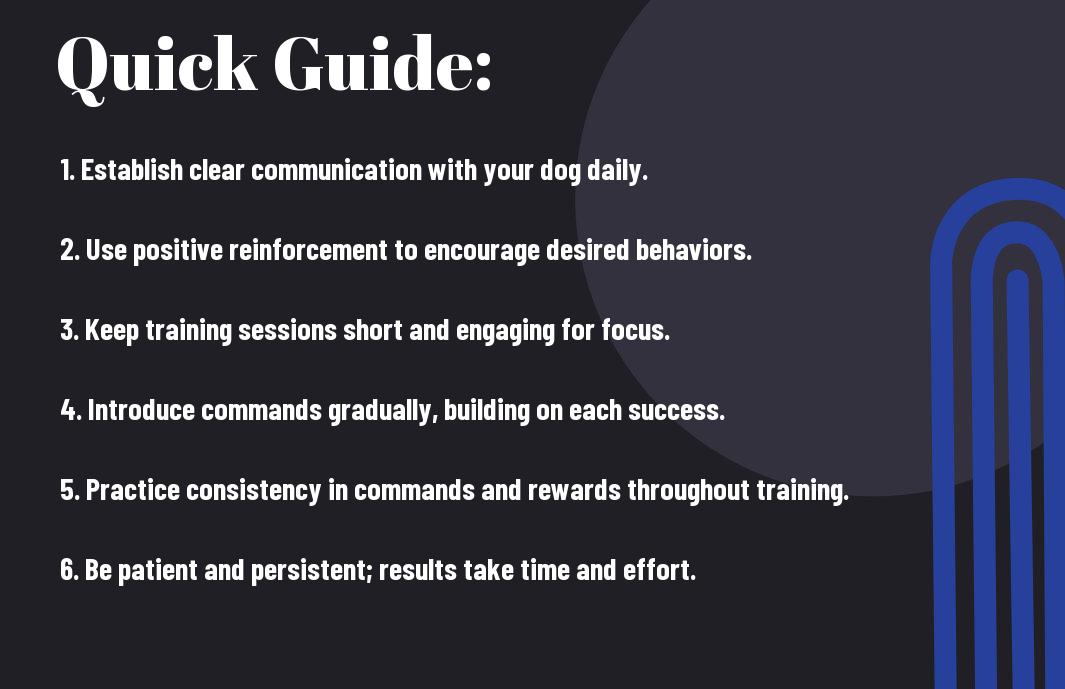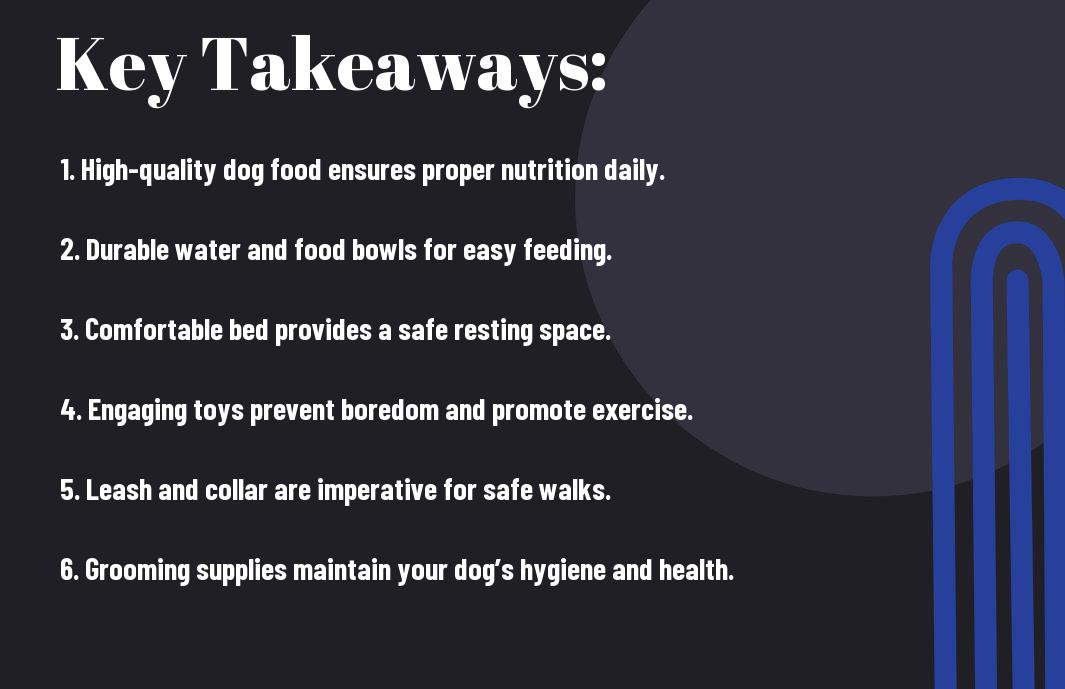Techniques for effective dog training can make a world of difference in your pet’s behavior and your relationship with them. In this comprehensive guide, you will explore positive reinforcement methods, discover imperative commands to teach, and learn how to avoid dangerous pitfalls that could hinder your progress. You’ll gain insights into creating a consistent training environment that fosters trust and understanding between you and your furry companion. Get ready to enhance your dog training skills and enjoy a happier, more obedient dog!

Understanding Dog Training Techniques
Before delving into specific strategies, it’s important to understand the variety of dog training techniques available. Each technique has its unique approach and philosophy, catering to different personality types in dogs and various training outcomes. By familiarizing yourself with these methods, you can make an informed decision that aligns with your dog’s specific needs and temperament.
Types of Dog Training
Clearly, the landscape of dog training is broad, encompassing several techniques. The table below outlines five popular dog training methods, providing an overview of their key characteristics and advantages:
| Training Technique | Description |
|---|---|
| Positive Reinforcement | Utilizes rewards like treats or praise to encourage desired behaviors. |
| Clicker Training | Employs a clicking sound to mark correct behavior followed by a reward. |
| Leash Training | Focuses on teaching your dog to walk calmly on a leash, enhancing control. |
| Modeling | Involves showing your dog what to do by demonstrating the behavior yourself. |
| Obedience Training | Emphasizes teaching basic commands like sit, stay, and come for safety. |
Any of these techniques can be effective, depending on your dog’s individual learning style and responsiveness. It’s important to be patient and consistent, as progress may vary from one dog to another.
Choosing the Right Technique for Your Dog
Types of dog training can significantly influence your dog’s learning and behavior modification. Understanding your dog’s personality, age, and past experiences can help you decide which technique will be most effective. For instance, if you have a particularly sensitive dog, a gentle method like positive reinforcement may be more suitable than aversive techniques.
Training your dog using the right technique requires careful consideration of your dog’s unique traits. Assess whether your dog thrives on rewards and praise, or if they respond better to structured routines. A well-rounded approach may also involve blending several methods to cater to your dog’s specific needs. Be sure to look for signs of stress or frustration in your dog, and adjust your technique accordingly for the most positive outcome.

The Ultimate Guide To Dog Training Techniques
Despite the various training approaches available today, understanding step-by-step training methods can significantly enhance your dog training journey. These methods break down complex commands into manageable segments, allowing both you and your dog to master the skills progressively. By applying these techniques consistently, you foster a strong bond with your furry companion and create a more positive training atmosphere.
Training Method Breakdown
| Training Type | Description |
| Positive Reinforcement | Rewarding desired behaviors with treats or praise to encourage their repetition. |
| Clicker Training | Using a clicker to mark good behavior, followed by a reward, to reinforce learning. |
| Leash Training | Teaching your dog to walk calmly on a leash without pulling. |
| Socialization | Exposing your dog to different environments, people, and other animals to promote good behavior. |
Basic Commands Training
With basic commands, you set the foundation for your dog’s training. Start with simple commands such as “sit,” “stay,” “come,” and “down.” Using positive reinforcement techniques will help establish your dog’s understanding of these commands, making the training process enjoyable for both of you. Be sure to practice these commands in short bursts, as dogs have shorter attention spans.
Additionally, consistency is key. Use the same verbal cues and gestures each time you train. By doing this, you’ll help your dog associate the command with the action you’re asking them to perform. Over time, your dog will begin to respond more quickly and reliably.
Advanced Commands Training
With advanced command training, you take your dog’s skills to the next level. These commands can enhance your dog’s obedience and make them a more well-rounded pet. Common advanced commands include “heel,” “leave it,” and “fetch.” These commands require more patience and a refined understanding from your dog, allowing you to work on building focus and impulse control.
To effectively train advanced commands, break the process down into small steps. Start by mastering the advanced command in a controlled environment before gradually introducing distractions. Always use positive reinforcement to encourage your dog’s progress and ensure that training sessions are kept fun and engaging.
Advanced Commands Training Techniques
| Technique | Description |
| Gradual Introduction | Introduce advanced commands slowly, ensuring your dog understands each step. |
| Controlled Environment | Start in a calm setting before transitioning to busier locations. |
| Distraction Training | Practice commands with various distractions to reinforce focus. |
Drop the distractions during early training sessions and gradually reintroduce them to improve your dog’s responsiveness. Utilize focus-based exercises to promote attention on you during commands. This further reinforces the importance of listening and responding, which can significantly enhance your dog’s behavior in various environments.
Advanced Commands Key Focus Points
| Key Points | Details |
| Clarity | Ensure your commands are clear and consistent. |
| Patience | Be patient as your dog learns; avoid frustration. |
| Positive Reinforcement | Always reward good behavior to encourage repeat performance. |
By focusing on these aspects within your advanced commands training, you lay the groundwork for a well-behaved dog, making future training endeavors smoother and more effective. Your commitment to following these steps not only benefits your dog but also deepens the bond between you both.

Training Tips for Success
For effective dog training, it’s imperative to follow specific strategies that would lead you and your dog to success. By incorporating certain principles into your training routine, you can create a more productive and enjoyable experience for both of you. Here is a list of helpful tips:
- Be consistent with commands and routines.
- Use positive reinforcement to encourage good behavior.
- Pay attention to timing when rewarding or correcting.
- Exhibit patience with your dog as they learn.
- Understand canine body language to enhance communication.
Recognizing these elements will help ensure a smoother training process and a stronger bond with your pet.
Consistency is Key
For successful training, establishing a consistent approach is imperative. When you use the same commands and cues each time you train, your dog will have a clearer understanding of what you expect from them. Consistency also extends to the rules you set within your home; when you enforce these rules uniformly, your dog will learn their boundaries and behave accordingly.
Moreover, it’s important to involve all family members in the training process. If different people use conflicting commands or rules, it may confuse your dog, leading to frustration for both you and your furry friend. Consistency in your approach lays the foundation for effective training and steady progress.
Timing and Rewards
For your training efforts to be truly effective, you must pay close attention to timing. Dogs live in the moment, and immediate rewards for good behavior can greatly reinforce that behavior. When your pup does something you want to encourage, whether it’s sitting on command or responding to a recall, providing a treat, praise, or affection right away is imperative. This immediate connection helps your dog associate their actions with the positive outcomes.
It’s also important to recognize the window of opportunity for corrections. If your dog makes an error, you should address it quickly but constructively. Waiting too long may lead to confusion about what behavior is being corrected, diminishing the effectiveness of your training efforts.
Understanding how to balance timing and rewards can lead to significant improvements in your dog’s learning curve. Keep in mind that the right timing will encourage your dog to repeat desired behaviors while appropriately addressing unwanted actions.
Patience and Perseverance
Assuming you’ve started your training with enthusiasm, you may soon realize that patience and perseverance are vital for success. Some dogs take longer than others to grasp new skills, and it’s important to understand that every dog learns at their own pace. Celebrate the small victories and be prepared to put in the time necessary to help your dog improve.
Additionally, there will be days when your dog may seem to regress or not respond as well to commands. This is completely normal, and it is crucial to maintain a calm and positive demeanor. By demonstrating patience and a continued effort, you’ll foster a supportive atmosphere that encourages learning and growth.
Consistency in your training approach can significantly impact your dog’s behavior over time, as repeated practice reinforces their learning process.
Understanding Canine Body Language
Perseverance in training extends beyond mere commands and rewards; it also involves understanding how your dog communicates. By being aware of your dog’s body language, you can better interpret their feelings and reactions during training sessions. From wagging tails to lowered ears, your dog’s body language can give you insightful clues about their emotional state and level of comfort.
Being able to read these signals is vital; for instance, if your dog appears anxious or fearful, it might be a sign to slow your training session or reassess your approach. Pay attention to your dog’s expressions, as they offer valuable insights that improve your communication and strengthen your bond.
Patience in interpreting canine body language can turn every training session into a more effective experience, allowing you to respond appropriately to your dog’s needs and feelings.
Factors Influencing Training Effectiveness
Now, as you initiate on your journey of dog training, it’s crucial to understand the various factors that can significantly impact the effectiveness of the techniques you choose to employ. Many elements come into play when considering how well your dog will respond to your training methods, including:
- Age of the Dog
- Environment and Distractions
- Owner’s Training Skills
Age of the Dog
Even though dogs of all ages can learn, the age of the dog plays a significant role in determining how effectively you can train your canine companion. Puppies, for instance, are generally more receptive to training as they are in their critical learning stage. Their brains are developing, and they are eager to absorb new information, making early socialization and basic commands vital to set a strong foundation.
On the other hand, older dogs may have established habits that can be more challenging to change. They may require more patience and time during training sessions. That said, it is certainly possible to teach an old dog new tricks; you just might need to tailor your approach to their unique personality and learning pace.
Environment and Distractions
Influencing the success of your training sessions, the environment and the distractions around you can make a significant difference. Training in a calm, quiet space is ideal for beginner sessions, helping your dog focus on your commands without overwhelming stimuli. Gradually, you should introduce distractions to help your dog learn to maintain focus in different situations, ultimately preparing them for real-world experiences.
A controlled environment can help reinforce the commands before moving to more challenging areas. You will want to ensure that your dog can concentrate on you despite any distractions. Keep in mind that significant events—like loud noises or sudden movements—can hinder their ability to learn effectively. It’s crucial that you consider the setting during each training session to maintain your dog’s attention and optimize learning.
Owner’s Training Skills
Even if you have the best intentions, your own training skills will greatly influence your dog’s learning experience. Your understanding of various dog training techniques, as well as your familiarity with your dog’s specific behaviors and needs, will determine how well you can convey commands and reinforce positive behavior. The more you educate yourself in effective methods, the more successful your training sessions are likely to be.
It is beneficial to attend workshops or read up on different training methods to enhance your own skills. This comprehensive understanding can empower you to address any challenges that arise during training and adapt your techniques accordingly to suit your dog’s unique personality. This will significantly increase the effectiveness of your training efforts and foster a stronger bond between you and your dog.
Pros and Cons of Different Training Techniques
All dog training techniques have their unique merits and drawbacks. Understanding these aspects can significantly impact how effectively you can train your pet. In the following table, you will find a breakdown of the pros and cons associated with several training methods:
| Training Technique | Pros and Cons |
|---|---|
| Positive Reinforcement | Pro: Builds trust and strengthens your bond with your dog. Con: Requires consistency and may take time to see results. |
| Negative Reinforcement | Pro: Can lead to faster compliance. Con: Can create fear and mistrust in your dog. |
| Clicker Training | Pro: Provides a clear signal to your dog when they perform the correct behavior. Con: Requires you to carry the clicker at all times. |
| Modeling | Pro: Dogs can learn behaviors by observing others. Con: Not always effective if the model is not a well-trained dog. |
| Socialization Techniques | Pro: Helps your dog become well-adjusted and friendly. Con: Requires time and patience to introduce them to different environments and stimuli. |
| Electronic Collars | Pro: Can be effective for controlling behavior from a distance. Con: Inconsistent use can lead to confusion and anxiety for the dog. |
| Behavior Adjustment Training (BAT) | Pro: Addresses behavioral concerns in a constructive manner. Con: May be complex for some owners to implement without guidance. |
| Positive Punishment | Pro: Can quickly deter unwanted behaviors. Con: Can harm your relationship with your dog and lead to fear-based responses. |
| Team Training | Pro: Encourages teamwork and communication between you and your dog. Con: Requires commitment to group sessions and might not fit all schedules. |
Pros of Positive Reinforcement
Now, one of the significant benefits of using positive reinforcement in your dog training is that it creates an environment of trust and cooperation. When your dog successfully connects behaviors with rewards, whether it’s treats, toys, or praise, they are likely to repeat those behaviors enthusiastically. This method fosters a strong bond between you and your pet, as they learn to view training sessions as enjoyable experiences rather than chores.
Moreover, positive reinforcement is effective across a variety of situations. It can be utilized for teaching basic commands, addressing behavioral issues, and even for more complex tasks. Because it encourages your dog to engage willingly, you will likely see quicker learning and better retention of behaviors when employing this method.
Cons of Negative Reinforcement
To fully grasp the implications of negative reinforcement, it’s important to acknowledge its primary drawback. This method can lead to fear and anxiety in your dog, which may result in adverse effects on their overall behavior and well-being. While negative reinforcement might produce quick results, the long-term consequences can be detrimental to your dog’s emotional health and your relationship with them.
The use of negative reinforcement can also make it challenging for your dog to distinguish between the desired behavior and the punishment. This method may confuse your pet and create a hostile training environment, potentially causing them to avoid you during training sessions.
With negative reinforcement, it’s important to weigh the risks involved. Dogs might become anxious or aggressive if they associate certain actions with discomfort. Building a relationship based on trust and understanding is far more likely to yield positive outcomes for both you and your dog.
Effectiveness of Socialization Techniques
The impact of socialization techniques in dog training is profound, as they lay the groundwork for your dog’s future interactions. By exposing your dog to various experiences, environments, and other animals from a young age, you help them develop confidence and adaptability. A well-socialized dog is more likely to exhibit positive behaviors, making them a more pleasant companion and improving their overall quality of life.
Additionally, socialization techniques reduce the likelihood of fear-based behaviors that can arise from unfamiliar situations. By reinforcing positive experiences in various contexts, your dog learns to remain calm and collected, enabling you to enjoy outings together.
This comprehensive approach to socialization not only mitigates behavioral issues but also sets your dog up for success. A well-socialized dog typically conducts themselves more appropriately in public, which makes walks and visits to dog parks much more enjoyable for you both.
Suitability of Various Training Tools
Any effective dog training plan must consider the tools you choose to utilize. Different training tools have distinct advantages and disadvantages, depending on the temperament and learning style of your dog. Whether you opt for collars, leashes, clickers, or training books, it’s important to align these tools with your training philosophy.
Using tools that complement your training methods can help streamline the process and amplify your success. Be sure to evaluate your dog’s response to each tool and adjust your approach accordingly for the best outcomes.
Negative training tools, such as prong collars or choke chains, can sometimes create more problems than solutions. They may induce fear or aggression, ultimately jeopardizing your bond with your pet. Therefore, always prioritize tools and methods that promote positive interactions and build trust between you and your dog.
Common Training Challenges and Solutions
Many dog owners encounter a variety of challenges during the training process. Addressing these common issues effectively is vital for fostering a positive relationship between you and your pet. Identifying the root causes of problematic behaviors can lead to more effective training solutions, helping you to create a more harmonious environment.
Dealing with Aggressive Behavior
The first step in managing aggressive behavior is to understand the triggers that lead to your dog’s aggression. Some dogs may become aggressive due to fear, anxiety, or perceived threats. By observing your dog’s behavior and body language, you can recognize situations that provoke aggression. Once you identify these scenarios, you can begin to manage and modify this behavior through appropriate training techniques such as positive reinforcement and desensitization.
If your dog displays aggressive tendencies towards other dogs or people, it is highly recommended to consult a professional dog trainer or a behaviorist. They can provide tailored advice and strategies to address the specific issues at hand. In some cases, using a muzzle during training may be necessary to ensure the safety of everyone involved, including your dog.
Managing Separation Anxiety
Clearly, separation anxiety can be a worrying issue for both you and your dog. This condition often manifests when your dog becomes overly attached and distressed when you are absent. You may notice signs such as barking, chewing, or house soiling as indications of your dog’s discomfort. To effectively manage separation anxiety, it’s vital to gradually desensitize your dog to your departures and arrivals, ensuring they understand that being alone is not a negative experience.
Training sessions that incorporate distraction techniques such as interactive toys or puzzles can keep your dog engaged while you are away, reducing anxiety. Additionally, establishing a consistent routine can help your dog feel more secure and less fearful of your absences.
Training your dog to cope with being alone takes time and patience, but it is achievable with consistency. Start with short periods away from home and gradually increase the duration as your dog becomes more comfortable. This gentle approach allows your dog to acclimatize to absences without overwhelming them.
Overcoming Fearful Reactions
Common reasons behind fearful reactions in dogs include lack of socialization, past trauma, or a predisposition towards nervousness. These reactions could manifest as cowering, growling, or even aggression when faced with certain stimuli or situations. To address these behaviors, it’s important to identify the specific fears your dog exhibits and work to desensitize them slowly.
Providing a safe space for your dog during moments of fear, combined with positive reinforcement strategies, can aid greatly in this training. Gradually expose your dog to the fearful stimuli, rewarding them with treats and praise for calm behavior. Over time, your dog will associate these experiences with positivity rather than fear.
To enhance your approach, try utilizing counter-conditioning, which involves changing your dog’s emotional response to a fear-inducing situation. For example, if your dog is afraid of loud noises, pair those sounds with treats or enjoyable activities. This technique slowly builds a more positive association, enabling your dog to confront their fears with confidence.
Final Words
To wrap up, mastering dog training techniques isn’t just about teaching your pet basic commands; it’s about building a positive relationship with your dog that encourages good behavior and mutual respect. You have a variety of approaches at your disposal, from positive reinforcement to clicker training, allowing you to choose the methods that best suit your dog’s personality and your training goals. Consistency, patience, and understanding are key components in your journey, ensuring that both you and your dog feel more comfortable and confident through the process.
As you implement these dog training techniques, keep in mind that every dog is unique. Adjust your training style as needed, and don’t hesitate to seek help from professional trainers if you encounter challenges. Your dedication to understanding and communicating with your furry friend will make a significant difference in their behavior and your relationship over time. Embrace the learning journey for both you and your dog, and you’ll find a rewarding companionship that enriches your lives together.
FAQ
Q: What are some effective dog training techniques mentioned in ‘The Ultimate Guide To Dog Training Techniques’?
A: The guide covers various effective dog training techniques, including positive reinforcement, clicker training, and leash training. Positive reinforcement involves rewarding desired behaviors with treats, praise, or playtime, making it more likely that the dog will repeat those behaviors. Clicker training utilizes a sound (the click) to mark the moment a desired action is performed, followed by a reward, which helps dogs learn to associate their actions with positive feedback. Leash training focuses on teaching dogs to walk calmly on a leash without pulling, enhancing control during walks.
Q: How can I assess my dog’s learning style according to the guide?
A: The guide suggests observing your dog’s behaviors and preferences to determine their learning style. Some dogs may respond better to visual cues, while others might prefer verbal commands or tactile guidance. For instance, a dog that quickly picks up commands when shown a gesture might be visually inclined, while one that reacts well to tone of voice may be more auditory. Spend time experimenting with different training methods and notice which ones lead to quicker understanding and compliance from your dog.
Q: What should I do if my dog is not responding to training techniques?
A: If your dog appears unresponsive to training techniques, the guide recommends assessing several factors. First, consider whether the training environment is free of distractions; a quiet, familiar space can often lead to better focus. Secondly, evaluate the timing of rewards; immediate reinforcement after a desired action strengthens the association between the behavior and the reward. Lastly, consult a professional trainer if needed, as they can provide personalized guidance tailored to your dog’s specific needs and challenges.










